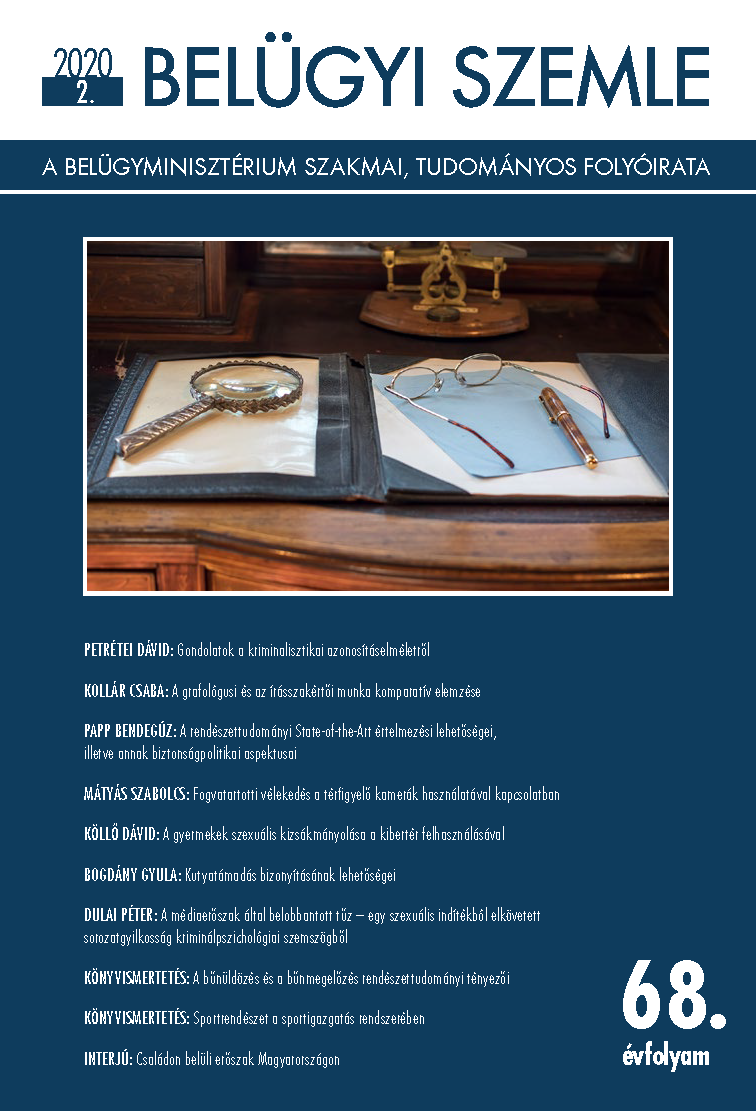Keywords
forensic science
identification
reconstruction
identification
reconstruction
How to Cite
Theoretical Issues of Forensic Identification. (2020). Academic Journal of Internal Affairs, 68(2), 7-22. https://doi.org/10.38146/BSZ.2020.2.1
Abstract
This paper is about the theoretical issues of forensic identification and individualization, comparison and reconstruction. Identification may be considered as the core point of forensic sciences. During crime scene processing or data mining the identification has paramount relevance. Psychological and philosophical aspects of identification, individualization and the so-called ACE-V methodology are also covered.
Downloads
Download data is not yet available.
Similar Articles
- András Vigh, Unorthodox questions of forensic identification theory , Academic Journal of Internal Affairs: Vol. 69 No. 10 (2021)
- Miklós Angyal, Asymmetric bars. Reflections on Gergely Gárdonyi: The Limits of Thought Reconstruction. Belügyi Szemle, 2013/10. , Academic Journal of Internal Affairs: Vol. 62 No. 3 (2014)
- Dávid Petrétei, Criminalistics, police science, forensic sciences – reflections on the anniversary of the Hungarian Association of Police Science , Academic Journal of Internal Affairs: Vol. 72 No. 5 (2024)
- Dávid Petrétei, Theoretical Issues of the Trace and Pattern Evidences in the 21th Century , Academic Journal of Internal Affairs: Vol. 70 No. 5 (2022)
- Csaba Fenyvesi, Crime Prevention Function of Criminalistics , Academic Journal of Internal Affairs: Vol. 69 No. 10 (2021)
- Gergely Gárdonyi, The limits of theoretical reconstruction , Academic Journal of Internal Affairs: Vol. 61 No. 10 (2013)
- Klaudia Lohner, Zsombor Hermann, József Haller, Traces of sexual motivation at the crime scene: from criminal psychology to forensics , Academic Journal of Internal Affairs: Vol. 69 No. 10 (2021)
- Csaba Fenyvesi, Global trends in forensic science in the 21st century , Academic Journal of Internal Affairs: Vol. 61 No. 10 (2013)
- Csaba Fenyvesi, The second version of the criminalist pyramid-model , Academic Journal of Internal Affairs: Vol. 62 No. 9 (2014)
- Dávid Petrétei, The Future of the Criminalistics, the Criminalistics of the Future , Academic Journal of Internal Affairs: Vol. 62 No. 10 (2014)
You may also start an advanced similarity search for this article.
Most read articles by the same author(s)
- Márton Lontai, Horolma Pamzsav, Dávid Petrétei, Artificial Intelligence in Forensic Sciences Revolution or Invasion? , Academic Journal of Internal Affairs: Vol. 72 No. 4 (2024)
- Dávid Petrétei, Criminalistics, police science, forensic sciences – reflections on the anniversary of the Hungarian Association of Police Science , Academic Journal of Internal Affairs: Vol. 72 No. 5 (2024)
- Márton Lontai, Horolma Pamzsav, Dávid Petrétei, Artificial Intelligence in Forensic Sciences Revolution or Invasion? Part II , Academic Journal of Internal Affairs: Vol. 72 No. 8 (2024)
- Márton Lontai, Horolma Pamjav, Dávid Petrétei, Artificial Intelligence in Forensic Sciences Revolution or Invasion? Part II , Academic Journal of Internal Affairs: Vol. 72 No. 8 (2024)
- Dávid Petrétei, Criminalistics, police science, forensic sciences – reflections on the anniversary of the Hungarian Association of Police Science , Academic Journal of Internal Affairs: Vol. 72 No. 5 (2024)
- Dávid Petrétei, The Future of the Criminalistics, the Criminalistics of the Future , Academic Journal of Internal Affairs: Vol. 62 No. 10 (2014)
- Dávid Petrétei, Theoretical Issues of the Trace and Pattern Evidences in the 21th Century , Academic Journal of Internal Affairs: Vol. 70 No. 5 (2022)
- Dávid Petrétei, Print development from human skin , Academic Journal of Internal Affairs: Vol. 63 No. 11 (2015)
- Dávid Petrétei , Modern Methods of Latent Print Development I - Physical Methods , Academic Journal of Internal Affairs: Vol. 71 No. 4 (2023)
- Dávid Petrétei, Blood pressure analysis as an innovative tool for site detection , Academic Journal of Internal Affairs: Vol. 65 No. 2 (2017)

